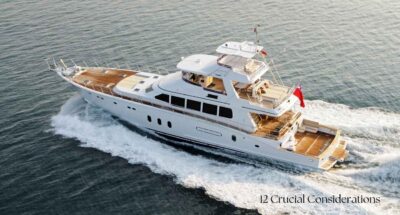When it comes to purchasing a yacht, one of the first decisions you’ll face is whether to buy new or secondhand. Both options come with their own set of advantages and challenges, depending on your budget, preferences, and long-term goals. A new yacht offers the latest technology and customization, while a secondhand yacht can provide significant savings. In this guide, we’ll explore the pros and cons of both new and secondhand yachts to help you make an informed decision.
1️⃣ Pro: Customization 🚤
One of the biggest advantages of purchasing a new yacht is the ability to fully customize the vessel to your preferences. When buying new, you have the freedom to make design choices that suit your lifestyle and needs, allowing you to create a yacht that is truly yours.
- Why Customization Matters: Customizing a yacht allows you to choose everything from the layout and materials to onboard technology and amenities. If you have specific preferences, such as a larger master suite, a dedicated office space, or upgraded entertainment systems, these can be integrated into your new yacht before it’s built. This level of personalization is a unique benefit of buying a new yacht, as it ensures the final product matches your exact specifications and lifestyle.
- How It Works: During the purchasing process, you’ll typically work closely with yacht designers and manufacturers. You can select interior finishes (wood types, fabrics, and flooring), decide on the layout (whether you prefer an open-plan salon or more compartmentalized rooms), and add custom features (like a gourmet kitchen or specialized deck space). Additionally, modern yachts often come with high-tech navigation systems, innovative hull designs for better fuel efficiency, and luxury finishes.
- Example: A couple purchasing a new yacht may decide to add a spacious sun deck with a hot tub, choose environmentally friendly materials like sustainable wood, and install a state-of-the-art sound system throughout the boat. All of these personalized touches ensure the yacht meets their exact vision for comfort and functionality.
- Pro Tip: Make sure to work with the yacht builder early on to create a detailed design plan. It’s essential to communicate your vision and expectations clearly to avoid any misunderstandings during the build.
1️⃣ Con: High Initial Cost 💸
While the allure of a brand-new yacht is undeniable, the significant upfront cost can be a major hurdle for many buyers. New yachts tend to come with hefty price tags, especially when factoring in customization and additional features. This can sometimes make new yachts feel out of reach for buyers with a more limited budget.
- Why It’s a Drawback: The high initial cost of a new yacht can include a range of expenses beyond the base price. Many yachts come with optional upgrades and add-ons (like larger engines, advanced navigation equipment, or luxury interior finishes) that increase the total cost. Additionally, there are taxes, registration fees, and sometimes delivery charges that can quickly add up. This large initial investment may require significant financing or even a complete reevaluation of your budget.
- How It Works: The cost of a new yacht can range from a few hundred thousand dollars for a smaller, more basic model to several million for larger, fully-equipped yachts with luxury features. For example, a 30-foot yacht might cost around $300,000, while a 70-foot yacht can reach upwards of $3 million or more. The customizations you choose, such as high-end materials or advanced technology, can further inflate the price.
- Example: A new 50-foot yacht with luxury finishes and advanced technology could cost around $1 million or more. For many buyers, that price point is higher than purchasing a secondhand yacht of a similar size, which may cost $500,000–$700,000, allowing for savings that can be put toward upgrades or other expenses.
- Pro Tip: If the upfront cost is a concern, look into financing options or leasing arrangements to ease the financial burden. It’s also worth considering a scaled-back version of the yacht to start with and upgrading over time as your business or finances grow.
2️⃣ Pro of Buying a New Yacht: Latest Technology & Features ⚙️
One of the biggest draws of purchasing a new yacht is access to the latest technology and features. With continuous advancements in yacht design, engineering, and onboard technology, buying new allows you to enjoy all the modern comforts and cutting-edge innovations available.
- Why It’s a Benefit: New yachts come equipped with the latest safety features, energy-efficient designs, and state-of-the-art navigation systems. As technology continues to evolve, new yachts are built with fuel-efficient engines, quieter propulsion systems, advanced electronic systems, and smart technologies that offer more comfort and convenience on the water.
- How It Works: Modern yachts may come with integrated smart systems, such as automated lighting, climate control, and security features, all controlled by mobile apps or onboard touchscreen interfaces. Additionally, newer engines are designed to be more fuel-efficient and eco-friendly, reducing emissions and operational costs.
- Example: A new yacht might come with a dual-mode hybrid engine that reduces fuel consumption and allows the boat to run on both electricity and traditional fuel, improving sustainability while maintaining high performance. For added comfort, many new yachts also come with advanced air filtration systems and noise-cancelling technologies, making onboard life more pleasant.
- Pro Tip: When buying a new yacht, make sure to choose the latest technology that fits your needs, and ensure that the yacht builder offers full support and warranty coverage for these systems.
2️⃣ Con of Buying a New Yacht: High Depreciation 🚫
While a new yacht offers a lot of appealing features, the moment it’s purchased, its value begins to depreciate—often rapidly. This means that if you plan to sell your yacht in the near future, you may not get back the amount you initially paid.
- Why It’s a Drawback: New yachts typically experience the highest depreciation in the first few years. It’s not uncommon for a new yacht to lose 15%–20% of its value as soon as it leaves the dealership or marina. Unlike real estate, which generally appreciates over time, yachts are considered luxury assets that depreciate quickly as they age, regardless of how well they are maintained.
- How It Works: The depreciation happens because a new yacht is priced at its highest value at the time of purchase. Once it’s used or even just put into the water, the resale value drops significantly. For example, if you purchase a new yacht for $1 million, after a couple of years of ownership, its market value may be closer to $800,000–$850,000.
- Example: A yacht buyer who decides to sell a new yacht after two years might face a significant loss in value—meaning they could sell it for $200,000 less than the original purchase price, which could be a huge financial hit.
- Pro Tip: If you are concerned about depreciation, try to buy a yacht with a proven track record of retaining its value or consider keeping it for a longer period to get the most out of your investment.
3️⃣ Pro: Warranty and Manufacturer Support 🛠️
A major benefit of purchasing a new yacht is the manufacturer warranty and support that come with it. Buying a new yacht often includes comprehensive warranties for the boat, engines, and other key components, which provides peace of mind and protection against unexpected repair costs during the first few years of ownership.
- Why It’s a Benefit: A warranty ensures that any defects in materials or workmanship are covered by the manufacturer, saving you from the costly burden of repairs. Most new yachts also come with 1-5 years of coverage for various components, including the hull, electronics, engines, and onboard systems.
- How It Works: When you buy a new yacht, the manufacturer guarantees the condition of the boat and its features. If anything goes wrong—such as an engine malfunction or issues with the navigation system—you’re typically covered under the warranty, so repair costs are either minimal or completely covered by the manufacturer. Additionally, manufacturers often provide ongoing technical support and advice for maintenance during the warranty period.
- Example: A new yacht with a 5-year engine warranty means that if the engine has any mechanical issues within that period, the manufacturer will either repair or replace it without charge, saving you thousands in repair costs.
- Pro Tip: Always read the warranty fine print to ensure it covers all the critical components, and be sure to follow the manufacturer’s maintenance schedule to keep the warranty valid.
3️⃣ Con: Longer Delivery Time ⏳
While a new yacht offers customization and the latest features, one downside is the often lengthy delivery time. Depending on the size of the yacht and the extent of the customizations, it can take several months—or even over a year—to receive the yacht after placing your order.
- Why It’s a Drawback: The time it takes to build, customize, and deliver a new yacht can be a significant disadvantage, especially if you want to use the yacht immediately. Long wait times can be frustrating, particularly for buyers eager to start their maritime adventures or businesses that require the yacht for commercial purposes.
- How It Works: Once you finalize your order, the manufacturer will begin building your yacht based on your specifications. This process involves sourcing materials, assembly, and ensuring that everything works perfectly, which can lead to delays, especially if there are high demand or supply chain issues. Customization, especially for large yachts, may add several additional months to the delivery timeline.
- Example: A buyer who orders a fully customized 50-foot yacht with special interior finishes and advanced technology might face a wait time of 6–12 months before the yacht is ready for delivery.
- Pro Tip: If timing is crucial, ask the dealer for an estimated delivery date and consider purchasing a model that’s already in production or has fewer customizations for a quicker turnaround.
4️⃣ Pro of Buying a New Yacht: Latest Safety Features 🚨
One of the standout benefits of purchasing a new yacht is the availability of the most up-to-date safety features. Yacht manufacturers prioritize the latest safety innovations to ensure that both the vessel and its passengers are protected from potential risks while on the water.
- Why It’s a Benefit: New yachts come equipped with advanced safety systems that not only enhance on-board protection but also help prevent accidents and mitigate risks. These include cutting-edge navigation systems, improved hull designs, fire suppression systems, and advanced water-rescue features.
- How It Works: Modern yachts come with a host of safety equipment, such as advanced GPS systems, collision detection sensors, automatic fire extinguishing systems, and state-of-the-art life-saving gear. These systems are designed to help you navigate tricky waters, avoid collisions, and respond quickly in case of an emergency. Additionally, many new yachts are designed with better stability and more robust hulls that reduce the chances of capsizing or taking on water.
- Example: A new yacht may come equipped with Integrated Collision Avoidance Systems that alert the captain if another vessel is too close, helping to prevent collisions. Other features like man-overboard systems that automatically activate alarms and deploy life-saving gear are often included as well.
- Pro Tip: When purchasing a new yacht, always check for the latest safety certifications and systems, ensuring your yacht is built to meet or exceed industry standards.
4️⃣ Con of Buying a New Yacht: Overwhelming Options and Decisions 🤯
While having a new yacht built to your exact specifications can be exciting, the sheer number of options and decisions can be overwhelming. From selecting materials and finishes to deciding on every technological feature, the process can become stressful and time-consuming.
- Why It’s a Drawback: The more customization options available, the harder it can be to narrow down choices and make decisions. The extensive list of features, upgrades, and configurations can lead to decision fatigue and even second-guessing your choices as the build progresses.
- How It Works: Customizing a yacht means choosing everything from the hull material to the onboard technology, from deck layout to interior décor. This level of personalization requires careful consideration and research. The more features and options you select, the longer it can take to finalize your design, which may delay the start of construction and lead to frustration.
- Example: A buyer may struggle to decide between various interior layouts, engine options, or technological features, which can significantly prolong the purchase process. Making the wrong choice could also lead to additional costs if you later decide to change certain aspects of the yacht.
- Pro Tip: Make a list of your “must-have” features and prioritize them before starting the customization process. Consult with experts and the yacht manufacturer to ensure that the choices you make are practical and meet your needs.
5️⃣ Pro of Buying a New Yacht: Brand New Condition 🆕
One of the key benefits of purchasing a new yacht is the pristine, brand-new condition of the vessel. Unlike secondhand yachts, which may have wear and tear, a new yacht is in perfect condition with no previous history of damage or repairs, offering peace of mind to the owner.
- Why It’s a Benefit: With a new yacht, you’re guaranteed that every component—from the hull to the onboard systems—is in top-notch condition. This eliminates concerns about hidden issues, such as leaks, engine problems, or old equipment that might need expensive repairs. Additionally, the yacht will be spotless, both inside and out, offering a luxurious and stress-free experience right from the start.
- How It Works: A new yacht comes with everything in pristine condition—clean interiors, freshly installed equipment, and systems that haven’t been subject to the wear and tear that comes with age. The yacht will be ready for immediate use without needing any repairs or upgrades.
- Example: When purchasing a new yacht, you don’t have to worry about unexpected mechanical failures or outdated equipment, which can be common with secondhand yachts. You can take your yacht out onto the water immediately, knowing that everything has been tested and is functioning perfectly.
- Pro Tip: While everything is brand new, it’s important to maintain your yacht through regular servicing to keep it in excellent condition for years to come.
5️⃣ Con of Buying a New Yacht: High Maintenance Costs 💸
Although new yachts come with warranties, they also come with high maintenance costs, especially when it comes to regular upkeep and occasional repairs. The larger the yacht and the more complex the features, the more expensive it can be to maintain.
- Why It’s a Drawback: While a new yacht’s warranty may cover certain repairs, there are ongoing maintenance costs that you’ll need to cover, such as cleaning, engine maintenance, hull inspections, and replacing outdated equipment. These costs can add up quickly, especially if you own a larger yacht with more complex systems.
- How It Works: Maintenance costs for a new yacht typically include routine services such as oil changes, cleaning, inspections, and seasonal preparations (such as winterizing the boat). The cost of docking, fuel, insurance, and crew (if applicable) also add to the overall maintenance burden.
- Example: On average, yacht owners spend about 10%–15% of the yacht’s purchase price annually on maintenance and upkeep. A $1 million yacht could cost around $100,000 per year to maintain, depending on size, type, and usage.
- Pro Tip: Budget for regular maintenance costs as part of your overall yacht ownership plan. Consider setting aside a contingency fund to avoid financial strain when repairs or unexpected upkeep arise.
Choosing between a new and a secondhand yacht comes down to personal preferences, budget, and long-term goals. New yachts offer customization, the latest technology, and the reassurance of a pristine vessel, but they come with high costs and depreciation. On the other hand, secondhand yachts provide savings and immediate availability but may require more maintenance and repairs. By carefully weighing the pros and cons of both options, you can make an informed decision that aligns with your needs and budget. Whether you choose a new yacht or a secondhand one, the goal is to enjoy your time on the water, knowing you’ve made a choice that works best for you.
Do you have any feedback or additional insights? Please send an email to editor @ yachtsurf.com





